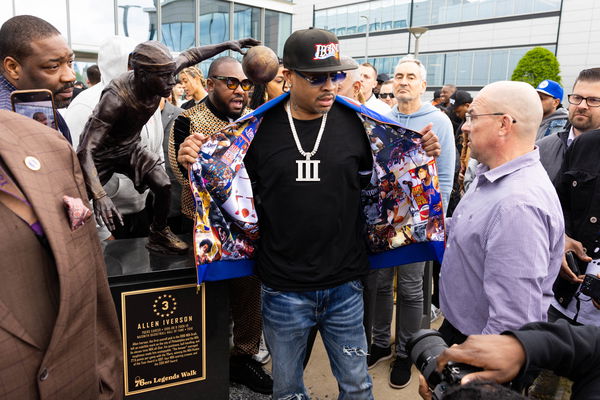

Everyone’s got the usual lineup of NBA legends—Magic, Bird, MJ, LeBron, Steph, Shaq. But if Allen Iverson’s not on that list, you’re leaving out the one who truly changed everything. He wasn’t just a four-time scoring champ (1999, 2001, 2002, 2005), an 11-time All-Star, or a two-time All-Star Game MVP. AI’s impact cut deeper than stats or accolades—it crossed into culture. He reached across sports, music, and identity itself, becoming a symbol for anyone, in any lane, who saw themselves in his fight, his fire, and his fearlessness.
Watch What’s Trending Now!
That same fearless spirit fuels Terence Crawford. Terence Crawford came from the tough corners of Omaha. His childhood was rough, full of fights, gang trouble, and even jail time. His own mom, trying to toughen him up, once paid kids to beat him up. And somehow, all that pain just pushed him harder. Today, he’s a global boxing star giving back to the same streets that tried to break him. And do you know who else understood that story? Well, it’s AI.
ADVERTISEMENT
On a recent episode of Ring Champs with AK and Barak, Terence “Bud” Crawford dropped a gem about his first-ever meeting with Allen Iverson—and it’s not what you’d expect. You’d think Bud, being the younger star, would be the one starstruck. But nope—AI was the first to light up. “Bud!” Iverson called out as soon as he saw him. Bud, stunned, could only fire back with a hilarious, “Iverson!”
View this post on Instagram
Crawford’s always been a fan—because honestly, who isn’t? But what shook him was that AI already knew his whole story. “I met Iverson years ago and he knew my whole story. I was just like, ‘What? He—it’s crazy, you know.’ Matter of fact, I met him here at Madison Square Garden,” Bud recalled on the podcast. And just like that, the roles flipped. “I was over there like, ‘Dog, man,’ and he was like, ‘Man, I’m a big fan, man.” Crawford laughed, still surprised by it.
ADVERTISEMENT
He added, “He was talking about, uh, Danny Garcia.” When asked which NBA star he resembled most, Crawford’s reply was immediate. “S—, Iverson.” The reason being? AI changed the “system.” And AI’s reaction to this chat was a simple “Wow!!! @tbudcrawford“, which he shared on his Instagram.
So let’s rewind to the amateur days—back when Terence “Bud” Crawford and Danny “Swift” Garcia were just hungry young fighters chasing dreams. They crossed paths twice in the ring: Garcia edged out Crawford in their first bout, but Crawford came back to win the rematch. These early battles were more than just wins and losses—they were the kind of gritty, proving-ground moments that shape champions. Both fighters went on to have stellar amateur careers: Crawford with a 58-12 record, and Garcia with an impressive 107-13. It’s no wonder Allen Iverson saw something familiar in Crawford’s journey.
ADVERTISEMENT
How did Allen Iverson change the NBA culture?
We all remember Post Malone dedicating “White Iverson” to Allen Iverson. And when Eminem shouted for Bud, “Make some noise for the next undisputed welterweight champion of the world!”—that was AI’s ripple effect in full view. That’s the bridge Iverson built. Before AI, the NBA looked nothing like the block. Before AI, fashion in basketball was stiff. Restrained. Suits and ties, “Sunday school” vibes, and buttoned-up everything. Then came this fearless 6-footer from Hampton, Virginia—rocking braids, tattoos, baggy jeans, and diamond chains—like he just stepped out of a Jadakiss video. “My thing was, I dressed like guys from my neighborhood… I wouldn’t wear a suit to a basketball game. I wear sweatpants or jeans, sneakers—and let’s hoop,” Iverson said to The Player’s Tribune.

USA Today via Reuters
Apr 12, 2024; Camden, NJ, USA; Philadelphia 76ers great Allen Iverson during the unveiling of the statue honoring him in a ceremony at the Philadelphia 76ers Training Complex. Mandatory Credit: Bill Streicher-USA TODAY Sports
Iverson wasn’t playing a role. He was the role. A walking, talking manifestation of the streets he came from. And kids saw that. He wasn’t 6’8” like Jordan. He was undersized, raw, and accessible. And when he stepped over Tyronn Lue in the 2001 NBA Finals? That wasn’t just a highlight—it was a cultural moment. He was hip-hop in a jersey. He was so committed to the look, he once finished getting his braids done during a game.
ADVERTISEMENT
That’s how serious the cornrows were to him. Then came his rap album. Sure, it wasn’t Grammy-worthy, but at the time, hoopers rapping and rappers hooping was the wave. And of course, there’s the shooting sleeve. It wasn’t even a fashion statement at first—it started after an injury—but once AI rocked it, the sleeve became a staple, even for players today.
AI didn’t just play; he reprogrammed the game. That style scared the NBA’s corporate image, leading to Stern’s dress code—“You want to market the guy, but not who he is… I took the ass-whooping for guys to be who they really are,” Iverson admitted. But players didn’t back down; they doubled down. NBA fashion exploded into a full-on runway with stars like Kyle Kuzma and Shai Gilgeous-Alexander leading the charge. Iverson made it possible for the league to embrace authentic Black culture on and off the court—and that legacy still shapes basketball today.
ADVERTISEMENT
Allen Iverson didn’t just inspire Terence “Bud” Crawford—he saw him, understood him, and passed the torch. Two legends from two different sports, bonded by grit, truth, and the power to change the system from the inside out.
ADVERTISEMENT
ADVERTISEMENT
ADVERTISEMENT

